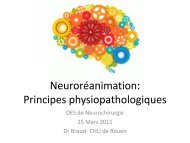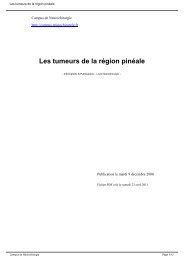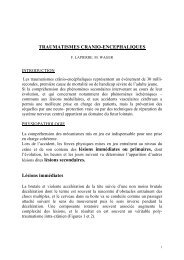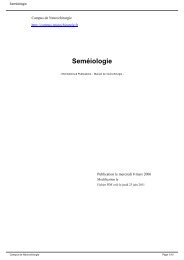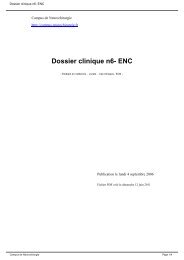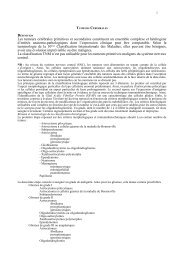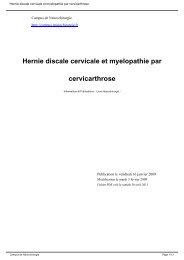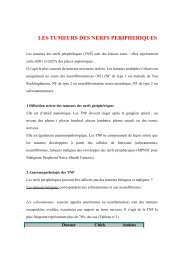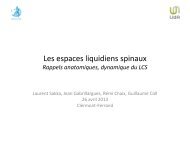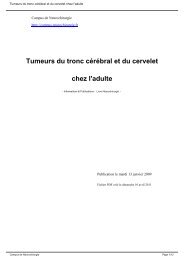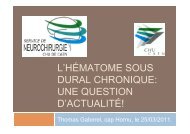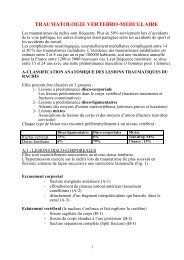Programme - Campus de Neurochirurgie
Programme - Campus de Neurochirurgie
Programme - Campus de Neurochirurgie
You also want an ePaper? Increase the reach of your titles
YUMPU automatically turns print PDFs into web optimized ePapers that Google loves.
Vol. 49, n° 2-3, 2003 BLOCS NEUROLYTIQUES ET SPASTICITÉ<br />
tique <strong>de</strong> la hanche. Ce <strong>de</strong>rnier handicap s’oppose<br />
en outre à la rééducation à la marche, et complique<br />
<strong>de</strong> manière non négligeable les soins d’hygiène périnéale.<br />
Au membre supérieur, la déformation en<br />
flexion <strong>de</strong> la main et du poignet s’oppose à la rééducation<br />
<strong>de</strong> la préhension, souvent aggravée par<br />
une spasticité du biceps qui empêche l’utilisation<br />
<strong>de</strong> la main, l’utilisation <strong>de</strong> cannes ou d’appareils<br />
<strong>de</strong> déambulation, l’habillage et l’utilisation d’orthèses.<br />
Enfin, la spasticité du muscle grand pectoral,<br />
la subluxation inférieure <strong>de</strong> la tête humérale<br />
qui en résulte et la douleur qui l’accompagne sont<br />
actuellement considérés comme une <strong>de</strong>s causes<br />
principales <strong>de</strong>s syndromes algodystrophiques fréquemment<br />
retrouvés chez ces mala<strong>de</strong>s. Les blocs<br />
neurolytiques, à l’ai<strong>de</strong> d’agents divers (phénol, alcool,<br />
glycérol) sont <strong>de</strong>puis longtemps proposés<br />
avec <strong>de</strong>s résultats variés et souvent controversés<br />
[26]. Outre la chirurgie (orthopédie et neurochirurgie),<br />
plusieurs approches thérapeutiques ont été<br />
proposées pour traiter la spasticité, incluant la kinésithérapie<br />
et diverses médications. L’approche<br />
pharmacologique (dantrolène, baclofène…) est<br />
parfois incomplètement efficace ou d’une efficacité<br />
transitoire. Ces traitements ne sont, en outre, pas<br />
dénués d’effets secondaires, en particulier au plan<br />
hépatique. Ailleurs, le programme <strong>de</strong> rééducation<br />
peut conserver et utiliser une spasticité du membre<br />
inférieur tout en souhaitant la faire disparaître au<br />
membre supérieur, nécessitant <strong>de</strong> fait une approche<br />
plus régionale que systémique. Enfin, une approche<br />
plus récente consiste à utiliser la toxine<br />
botulinique [1, 8], dont l’efficacité est validée dans<br />
la prise en charge du blépharospasme et du torticolis<br />
spasmodique. L’efficacité <strong>de</strong> cette approche<br />
dans la prise en charge <strong>de</strong> la spasticité <strong>de</strong>s membres<br />
est en cours d’évaluation. L’obstacle principal,<br />
à l’heure actuelle, à une large extension <strong>de</strong><br />
l’utilisation <strong>de</strong> la toxine rési<strong>de</strong> dans son coût particulièrement<br />
élevé. La réalisation <strong>de</strong> blocs neurolytiques,<br />
grâce à l’utilisation <strong>de</strong> techniques <strong>de</strong><br />
repérage fiable (neurostimulation), représente à<br />
l’heure actuelle une approche simple et efficace,<br />
qui se caractérise en outre par un prix <strong>de</strong> revient<br />
extrêmement peu élevé [17].<br />
RÉFÉRENCES<br />
[1] CHIRONNA<br />
RL, HECHT<br />
JS. Subscapularis motor point<br />
block for the painful hemiplegic shoul<strong>de</strong>r. Arch Phys<br />
Med Rehabil 1990 ; 71 : 428-429.<br />
[2] DELOYE<br />
F, SCHIAVO<br />
G, DOUSSAU<br />
F, ROSSETTO<br />
O,<br />
MONTECUCCO<br />
C, Poulain B. Mo<strong>de</strong> d’action moléculaire<br />
<strong>de</strong>s neurotoxines botuliques et tétanique. Med Sci<br />
1996 ; 12 ; 175-182.<br />
[3] ENJALBERT<br />
M, VIEL<br />
E, TOULEMONDE<br />
M, KOTZKY<br />
N,<br />
PELISSIER<br />
J, ELEDJAM<br />
JJ. Neurolyse chimique à l’alcool<br />
et spasticité <strong>de</strong> l’hémiplégique. Ann Readaptation Med<br />
Phys 1993 ; 36 : 337-342.<br />
261<br />
[4] ESSAM<br />
AA. Phenol block for control of hip flexor and<br />
adductor spasticity. Arch Phys Med Rehabil 1972 ; 53 :<br />
554-555.<br />
[5] GASPARICH<br />
JP, MASON<br />
JT, BERGER<br />
RE. Use of nerve<br />
stimulator for simple and accurate obturator nerve<br />
block before transurethral resection. J Urol 1984 ; 132 :<br />
291-293.<br />
[6] GRIFFIN<br />
JW. Hemiplegic shoul<strong>de</strong>r pain. Phys Ther<br />
1986 ; 66 : 1884-1893.<br />
[7] JAIN<br />
S, GUPTA<br />
R. Neurolytic agents in clinical practice.<br />
In : Waldman SD, Winnie AP, eds. Interventional pain<br />
management. Phila<strong>de</strong>lphia : WB Saun<strong>de</strong>rs Company,<br />
1996 : 167-171.<br />
[8] JAIN<br />
S. The role of neurolytic procedures. In : Parris<br />
WCV, ed. Cancer pain management. Boston : Butterworth-Heinemann,<br />
1997 : 231-243.<br />
[9] KAKI<br />
AM, LEWIS<br />
GW. Inguinal paravascular (lumbar<br />
plexus) neurolytic block. Description of a catheter technique<br />
: case report. Reg Anesth Pain Med 1998 ; 23 :<br />
214-218.<br />
[10] KIM<br />
PS, FERRANTE<br />
FM. Cryoanalgesia : a novel treatment<br />
for hip adductor spasticity and obturator neuralgia.<br />
Anesthesiology 1998 ; 89 : 534-536.<br />
[11] LABAT<br />
G. Regional anesthesia : its techniques and clinical<br />
application. Phila<strong>de</strong>lphia : WB Saun<strong>de</strong>rs, 1928.<br />
[12] LOUBSER<br />
PG, CASTRO<br />
JP. Control of lower extremity<br />
spasticity with lumbar paravertebral blocks. Anesthesiology<br />
1993 ; 79 (3A) : A 822.<br />
[13] LOUBSER PG. Neurolytic interventions for upper extremity<br />
spasticity associated with head injury. Reg Anesth<br />
1997 ; 22 : 386-387.<br />
[14] MAGORA F, ROZEN R, BEN MENACHEM, MAGORA A.<br />
Obturator nerve block : an evaluation of technique. Br<br />
J Anaesth 1969 ; 41 : 695-701.<br />
[15] MYERS RR, KATZ J. Drugs commonly used for nerve<br />
blocking : Neurolytic agents. In : Raj PP, ed. Practical<br />
management of pain. Saint Louis : Mosby Year Book,<br />
1992 : 701-712.<br />
[16] PATT RB. Peripheral neurolysis and the management of<br />
cancer pain. In : Patt RB, ed. Cancer pain. Phila<strong>de</strong>lphia<br />
: JB Lippincott, 1993 : 359-377.<br />
[17] PELISSIER J. Quel est l’apport <strong>de</strong>s injections d’alcool ou<br />
<strong>de</strong> toxine botulinique, <strong>de</strong> l’appareillage et <strong>de</strong> la chirurgie<br />
dans la récupération <strong>de</strong> la marche <strong>de</strong> l’hémiplégique<br />
? Ann Readapt Med Phys 1997 ; 40 : 265-278.<br />
[18] PELISSIER J, ENJALBERT J, KOTZKI N, VIEL E. L’algodystrophie<br />
du membre supérieur hémiplégique. In :<br />
Société Francophone d’Étu<strong>de</strong> <strong>de</strong> la Douleur, ed. Mises<br />
au point 1997. Montpellier : Sauramps Médical, 1997 :<br />
119-130.<br />
[19] PERENNOU D, ENJALBERT M, VIEL E, PELISSIER J, ELE-<br />
DJAM JJ. Neurolyse chimique à l’alcool : y a-t-il <strong>de</strong>s<br />
effets indésirables sur la somesthésie ? Ann Readapt<br />
Med Phys 1996 ; 39 : 416.<br />
[20] PIERROT-DESEILLIGNY E, PINAULT C, BUSSEL B, HELD<br />
JP. Traitement <strong>de</strong> la spasticité par infiltration d’alcool<br />
dilué au contact du SPI. Ann Med Phys 1970 ; 13 : 544-<br />
548.<br />
[21] SERRIE A, THUREL C, LANGLADE A. Palliative regional<br />
anaesthesia for home-care patients. Curr Opin Anaesth<br />
1994 ; 7 : 448-451.<br />
[22] SNOW BJ, TSUI JK, BHATT MH, VARELAS M, HASHI-<br />
MOTO SA, CALNE DB. Treatment of spasticity with<br />
botulinum toxin : a double blind study. Ann Neurol<br />
1990 ; 28 : 512-515.



